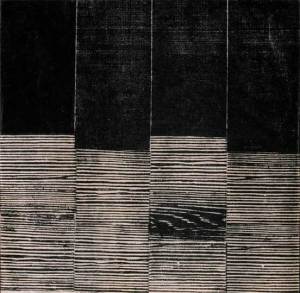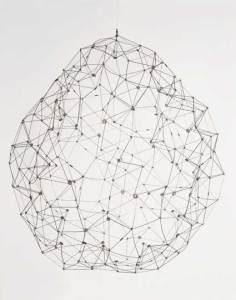There’s something timeless about geometric art, with its clean lines and basic patterns appealing to an instinctive desire for order. All the works included in the Royal Academy of Arts (RA) show ‘Radical Geometry’ all date from the mid 20th century, but they still feel modern. The artists, from Brazil, Uruguay, Argentina and Venezuela, turned to this visual language, fresh and subversive at the time, to express optimism for the future. This fruitful 50-year period coincided with a turbulent and often repressive political climate, with a solid streak of radicalism running through everything. The future was close, and change felt possible.
Untitled (from the series Weaving) (1959), Lygia Pape © Projeto Lygia Pape

The overarching mood of radical optimism colours the experience of the RA show. The Uruguayan and Argentine sections start us off with block colours in a subdued spectrum of dusty purple and muddy yellow, as the artists searched for a universal visual language. The boldness comes in the Brazilian section, where the colours change to unapologetic black, white and red, in shapes that fit together in neatly ordered ways.
Lygia Pape is only represented with a couple of wood-cuts, but her work was essential to the Brazilian artistic identity, championing art as a merging of the aesthetic, ethical and political. ‘Magnetised Space’, the 2012 Pape retrospective at the Serpentine Gallery, included an installation where Pape had strung gold threads from floor to ceiling; sometimes the threads seemed to disappear into nothing, but two steps to the side and they looked like rays of light. Closer inspection showed it to be perfectly logical in neat geometry, but the effect is magical.
Sphere (1976), Gego (Gertrude Goldschmidt. © Fundacion Gego

In ‘Radical Geometry’ the works by Gego (Gertrude Goldschmidt) have a similar effect. Using wire and found objects, Gego joined her Venezuelan contemporaries in creating optical illusions, meaning the art changes depending on the viewer. Sphere seems to be floating in air, impossibly connected at each joint. On the floor, the shadow is its own experience, unrecognisable yet inseparable from the original.
The sense of order and possibility in geometrical art comes in part from the mathematics at the core: the angles, the slots that fit. We are attracted to these shapes because they are natural to us: ‘Magnetised Space’ revealed our instinct for geometry through a still from Pape’s film, in which a street performer dances in the middle of a crowd which has formed in a perfect circle around him. It is like the dancer is magnetic, attracting the crowd and repelling it at the same time, with geometry as a human impulse.
The link between radicalism and geometry was thoroughly examined in the ‘The Utopian Impulse’, the elegantly titled Buckminster Fuller retrospective at the San Francisco Museum of Modern Art in 2012. The futuristic designer called himself a radical idealist, dreaming up fantastic solutions to humanity’s problems. Prone to geometric designs, Fuller patented his solutions for energy-efficient housing and uniquely fuel-efficient cars, even lunar colonies, in his kooky style that left you feeling like anything was possible.
‘The Utopian Impulse’ included the 1969 Earth Flag, made by Norman La Liberte and John McConnell; it’s a grey and white planet on a blue background. Few artists today would present the idea of world unity in such a simple way, as it feels distinctly nostalgic, a throwback to simpler times. But considering how geometry, a fundamentally appealing visual language, keeps emerging in the artistic landscape, we still cannot quell our impulse towards some kind of utopia. Looking at Gego’s hovering spheres, or Pape’s floating threads, we are swooning over the chance to create order in what we see.
‘Radical Geometry’ is at the Royal Academy of Arts, London, until 28 September.



